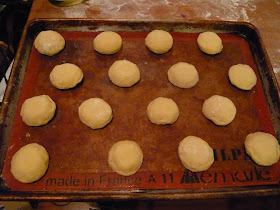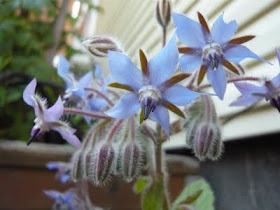Sunday, December 18, 2011
What Pate a Choux can do for you!
Tuesday, December 13, 2011
Catching up...
1) Pesto. I was gifted some basil starts in the spring after I killed the one basil plant I bought. I babied these basils unlike any plant I've ever grown before. I kept them in black pots so that when it was warm enough to be outside, the sun would warm the soil around there roots. I talked to them everyday and gently touched them so they would feel loved. It was quite a labor of love and in the end, I was able to make a pretty significant amount of pesto! I froze the pesto into ice cubes, so we can save some for winter when we're pining for a taste of summer.
2) Tater-tots: BAD idea! Perhaps I did this all wrong, but making home-made tater-tots turned into an inferno of spontaneous hot-oil explosions. That tater-tot on top of the stack is one of the culprits - they basically popped like popcorn in the oil.

3) Decibel Festival is a 5-day electronic music festival in Seattle that just so happened to fall precisely in line with the first week of school this year. Alex and I discovered that Breakfast For Dinner was the fuel required to sustain five-days of non-stop dancing and school. We had black tea, pancakes, Skagit River Valley Ranch breakfast sausage, and veggie omelets with fresh avocados that I smuggled back from California. Nothing like an avacado fresh off the tree! mmmm!
 Also, North Hill Bakery was right down the street from the Decibel in the Park show, so we could eat amazing ham-and-cheese croissants while groovin' to some delicious music.
Also, North Hill Bakery was right down the street from the Decibel in the Park show, so we could eat amazing ham-and-cheese croissants while groovin' to some delicious music.Thursday, October 13, 2011
Pumpkin Pumpkin Pumpkin
Tuesday, September 13, 2011
On Food and Culture
I developed a passion for food and cooking at a young age when I
realized that food is the center of life.
Food is everything. Food can
induce any emotion, bring people together or divide them apart. There’s food in your yard, the gas you put in
your tank is ancient, geologically fermented food, not to mention we are all
participating in one grand food chain that binds us all together under one
universal consciousness, or something. That
was my teenage idealism, which I still believe in, but it’s developed with
age. This food passion is what drove me
to become a Biology major and I have a sort of constant meditation churning
away inside my brain contemplating all things food. I had an experience earlier this year that
shook my beliefs on food and I realized on my bike-ride to work today that I
need to address this, so here it is.
I generally pride myself in being simultaneously conscious of the
things I eat, while respecting and partaking in the food of others. “You are what you eat” is a common saying
that I take seriously, in two ways. First, the molecules that make up what you
consume will be used to create and re-build your own flesh. Secondly, we all have an emotional
relationship with our food and I believe that we all take pride in or at least
enjoy food to some extent. Therefore,
what we eat is also an outward expression of who we are and by sharing food, we
are sharing ourselves. This is why I
don’t push my own food beliefs on other people.
Whenever I hear someone reject food that is offered to them, I am instinctively
offended. I feel like the person
rejecting is somehow culturally disrespecting the person who is offering food,
even if that’s not the intension. I’m
generally talking about vegetarians, vegans, raw-foodists, etc. - people who
have chosen a diet for reasons other than an allergy or diagnosed medical
condition. However, this raises the
question of what is the difference between food and medicine, and then how do
we culturally deal with the difference, if there is a difference? I eat the way that I do because it makes me
feel good and healthy. When I went to
visit family earlier this year I spent the week generally eating the way that
they eat and I ended up getting incredibly sick. Asian
cultures (Chinese, Indian, Japanese…) tend to blur the lines much more between
food and medicine than we do here in the US.
National Geographic recently reported on a new archeological find from some
ancient European civilization (Rome?): medicinal pills made out of onions, celery,
and other common vegetables that we would probably consider as food and not
medicine now.
So how do we develop and share a vibrant culture of food, if everyone
has their own individual eating habits?
I think what I’m beginning to realize is that it is about
communication. Communicating with yourself
to gain an intimate understanding of your body’s needs so that you can
communicate with others to let them know what you do or do not need. I think the key is going about it respectfully,
though, and discussing any foody disagreements with the understanding that everyone’s
body chemistry and culture is fairly different, and that’s okay.
Wednesday, August 31, 2011
Lobster Mushroom #4 - Tempura


Tuesday, August 30, 2011
Blue Cheese Cheesecake Bacon Maple Donuts






Sunday, August 28, 2011
Saturday, August 27, 2011
Fish & Chips


Sunday, August 14, 2011
Grilled Cheese and Tomato Salad

Mead
My buddy, Mark, has a friend who has a father in Aberdeen that makes honey. His bees pollinate the flowers of Cascara trees, which is an incredibly important tree for the native peoples of this land. Way back in the day, before semis and international shipping, people here in Cascadia lived largely off of berries, nuts, roots, and wild game. Just before winter they built a long house, stocked it with food, and everyone "hibernated" in the long house for the winter eating only what they could preserve from the summer. Then in late spring, the salmon start running. Salmon are packed with calories and nutrients and it's tradition for all omnivorous/carnivorous creatures of this region to gorge themselves on salmon when the opportunity presents itself. Now, as you can imagine, eating nothing but ridiculous amounts of salmon after fasting on berries and nuts all winter can get a little digestively complicated. This is where Cascara comes in - the bark of Cascara is a laxative. According to Mark's friend, it's in quite high demand year-round, and growing up in Aberdeen kids used to make money by harvesting and selling Cascara bark. They would also play pranks on each other by saying the bark was natures candy... you know the jokes on you when you end up running for bathroom.

Tuesday, August 9, 2011
Whiskey Earl Grey Ice Cream

Monday, August 8, 2011
Summer!

Sunday, July 31, 2011
It's Chinese or something...

Sunday, July 17, 2011
Poppy
I worked under Chef Jerry Traunfeld when he was at the Herbfarm, so I've been wanting to check out Poppy ever since it opened a couple years ago. When I was at the Herbfarm, it was during Jerry's final years there and I could tell he was suffering burn out. He used to talk about how much he hated the excessive decor of the Herbfarm and he dreamed of the day when he would have is own restaurant with simple minimalist decor. I strolled by Poppy right after it had opened. As soon as I saw the bold 4-color scheme (red, yellow, black, and white), bare walls, and simple tables - I knew this restaurant was everything Jerry had been wanting to do, but wasn't able to as long as he worked for someone else. This revelation is quite exciting, knowing what a phenomenal chef Jerry is. I could only imagine what culinary magic he would create when given complete and total freedom.


morel mushroom, english pea, and sage risotto
gothberg goat cheese agnolotti with fresh porcini and favas
carrot and black cardamom soup
cucumber raita with caraway and almond
radish, and grilled spring onion salad
beets with spice bread and mint
zucchini and basil gratin
local roots broccoli with oregano
bing cherry pickle
nigella-poppy naan
Alex's platter is on the opposite side of the table:
quillayute king salmon with pinot noir sauce, sea beans and bacon
tails and trotters pork loin with green sauce and corona beans
chilled fennel yogurt soup
cucumber raita with caraway and almond
radish, and grilled spring onion salad
snap peas with lemon thyme
beets with spice bread and mint
zucchini and basil gratin
mango, strawberry and peppermint pickle
nigella-poppy naan
Each dish was only a few bites, but it was still a LOT of food! Without realizing it, we spent nearly 3 hours trying to finish eating everything and we were on the verge of being painfully full by the end of it. As we were eating, we tried to put the experience into words, and final ended up drawing a graph. Complexity is on the x-axis, and Number of Dimensions is on the y-axis. If you plot each dish on this graph, I believe you would come up with a distribution that has it's mean at a very low level of complexity, but high number of dimensions. Like this:

Wednesday, July 13, 2011
Edible Flowers









Monday, July 11, 2011
Morels!!




Tuesday, May 24, 2011
Katrina Cakes!

Monday, May 23, 2011
Dinner for one
















